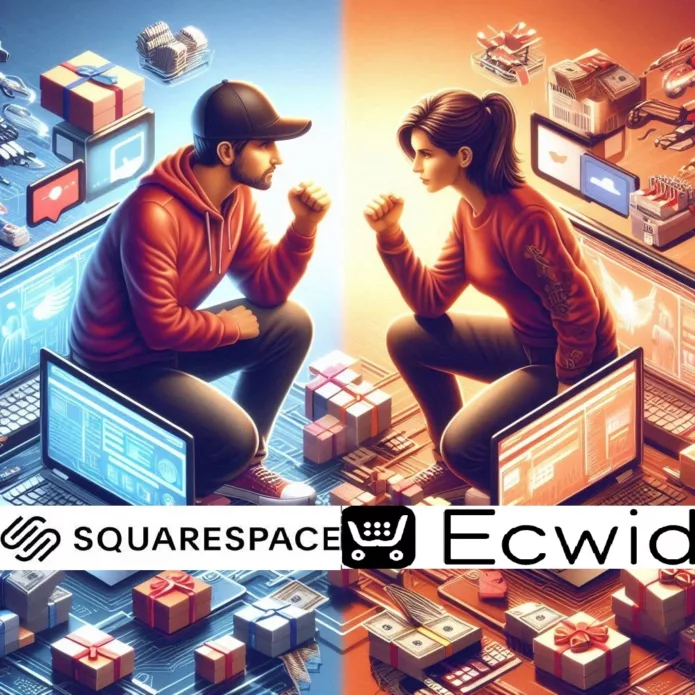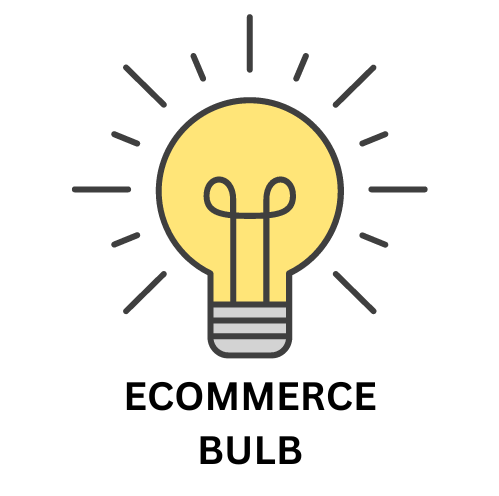In order to decide which ecommerce platform to use, SquareSpace vs Ecwid. A detailed comparison between features must be thoroughly done. If you want to decide which eCommerce platform to choose, there are many things to consider.
These are some examples of these factors:
- Cost.
- SEO friendliness.
- Page load speed.
- Canonical website URL.
- Indexing Control.
- Customizable HTML capabilities.
- Sitemap Generator.
- Integration with Google Analytics.
- Product Tagging and Categorization.
- Batch Uploading.
- Mobile Optimization.
- Built-in Blogging and Marketing Features.
- Social Sharing Buttons.
- Content Management Capabilities.
- Discount and promotion code tools.
- Easy to use Checkout.
- Reporting tools and custom reports.
- Integration of email marketing tools.
- Multiple payment options.
- Flexibility to add new eCommerce features.
- Exclusive features.
- Cons and pros.
Here we’ll discuss these factors to help you decide which platform is better for you, Ecwid or SquareSpace. And at the end of the discussion, we’ll recap and make a comparison for the scores of all these points to find out which eCommerce platform has the higher score, so that you’ll have a good view about both of them.

Pricing (SquareSpace vs Ecwid):

Squarespace
Squarespace offers four website plans, with some including e-commerce features:
- Personal: $16/month (paid annually) or $25/month (paid monthly) – No e-commerce features. Ideal for basic websites, blogs, or portfolios.
- Business: $23/month (paid annually) or $33/month (paid monthly) – Includes basic e-commerce features like product listings, inventory management, and secure checkout.
- Commerce Basic: $27/month (paid annually) or $39/month (paid monthly) – More advanced e-commerce features like abandoned cart recovery, customer accounts, and product discounts.
- Commerce Advanced: $49/month (paid annually) or $65/month (paid monthly) – The most comprehensive e-commerce plan with features like subscriptions, real-time shipping rates, and advanced marketing tools.
Important Notes on Squarespace Pricing:
- Squarespace offers a discount if you pay annually compared to monthly billing.
- Transaction fees apply to the Business plan (3% per sale). Higher e-commerce plans (Commerce Basic and Advanced) waive Squarespace’s transaction fees, but you’ll still be subject to payment processor fees.
- A free custom domain is included for the first year with an annual plan. You’ll need to renew it after that (usually around $20-40 per year depending on the registrar).
Ecwid
Ecwid offers a freemium model with paid plans offering additional features:
- Free: Supports up to 10 products, limited bandwidth, and basic features. Ideal for trying out Ecwid or selling a small number of products.
- Venture: $15/month – Up to 100 products, bandwidth increase, product variants, and discount codes.
- Business: $35/month – Up to 2500 products, abandoned cart recovery, real-time shipping rates, and product reviews.
- Unlimited: $99/month – Unlimited products, bandwidth, and advanced features like product memberships and API access.
Important Notes on Ecwid Pricing:
- Ecwid pricing is listed monthly, with potential annual discounts available.
- Ecwid itself doesn’t charge transaction fees. However, payment processors might have their own fees associated with each sale.
- You don’t get a free custom domain with Ecwid. You’ll need to purchase it separately from a domain registrar.
Here’s a table summarizing the key points:
| Feature | Squarespace | Ecwid |
|---|---|---|
| Pricing Model | Paid plans, Discounts for annual billing | Freemium, Paid plans, Potential annual discounts |
| E-commerce Features | Basic to Advanced (depending on plan) | Basic to Advanced (depending on plan) |
| Transaction Fees | 3% for Business plan, waived for higher e-commerce plans (payment processor fees still apply) | None, payment processor fees apply |
| Free Domain | For the first year with an annual plan (renewal fees apply) | No |

SEO Capabilities (SquareSpace vs Ecwid):

Squarespace
- Strengths:
- Built-in SEO tools: Squarespace offers basic SEO tools like:
- Title tag and meta description editing for pages and products
- Mobile-friendly website design (important for SEO)
- SSL certificate (encrypts website data, a ranking factor)
- Sitemap generation (helps search engines find your content)
- Easy to Use: Squarespace’s interface makes managing SEO aspects of your website straightforward, even for beginners.
- Clean URLs: Squarespace automatically generates clean and readable URLs for your pages and products, which can be beneficial for SEO.
- Built-in SEO tools: Squarespace offers basic SEO tools like:
- Weaknesses:
- Limited Customization: Squarespace’s SEO tools offer limited control compared to more technical SEO options.
- No Access to Raw Code: You can’t directly access and edit the website’s code, which restricts advanced SEO optimization techniques.
- Limited Content Editing Options: Squarespace’s content editor might not offer the same level of flexibility for optimizing content structure compared to some platforms.
Ecwid
- Strengths:
- Focus on Product SEO: Ecwid offers basic SEO tools focused on product pages, like:
- Product title and description optimization
- Category and tag management
- Integration with Google Shopping (can improve product visibility)
- Flexibility: Since Ecwid integrates with existing websites, you can leverage the SEO functionalities of your chosen website platform alongside Ecwid’s product-specific SEO features.
- Potential for Advanced SEO: If your existing website platform offers advanced SEO tools, you can combine them with Ecwid for a more comprehensive approach.
- Focus on Product SEO: Ecwid offers basic SEO tools focused on product pages, like:
- Weaknesses:
- Limited Control Within Ecwid: Ecwid’s built-in SEO tools are basic. Most SEO optimization will happen on the platform your Ecwid store is integrated with.
- Technical Knowledge Needed: Setting up and utilizing Ecwid effectively for SEO might require some technical knowledge or reliance on your website platform’s SEO features.
- Reliance on Another Platform: Your website platform’s SEO capabilities significantly impact your overall SEO success with Ecwid.
Here’s a table summarizing the key points:
| Feature | Squarespace | Ecwid |
|---|---|---|
| SEO Tools | Built-in basic tools (titles, descriptions, mobile-friendly, SSL, sitemap) | Limited built-in tools (product SEO), Relies on your website platform’s SEO functionalities |
| Ease of Use | Easy to use interface for basic SEO management | Requires some technical knowledge or reliance on your website platform’s SEO features |
| Customization | Limited customization options | More flexible depending on your website platform’s SEO capabilities |

Page Load Speed (SquareSpace vs Ecwid):

Squarespace:
- Strengths:
- Optimized Servers: Squarespace utilizes optimized servers with content delivery networks (CDNs) that can improve website loading speed globally.
- Image Optimization: Squarespace automatically optimizes image sizes and quality upon upload, reducing file size and potentially improving load speed.
- Clean Code: Squarespace uses clean and efficient code, which can contribute to faster page loading times.
- Weaknesses:
- Limited Control: Squarespace offers limited control over website code and server-side optimizations, making it difficult to fine-tune page load speed for advanced users.
- Template Complexity: Complex website templates with many elements or features can increase page size and potentially slow down loading times.
- Third-Party Integrations: Adding third-party plugins or integrations can introduce additional code and potentially slow down your website.
Ecwid:
- Strengths:
- Lightweight Code: Ecwid itself is a lightweight script that integrates with your existing website. This can minimize the impact on your website’s base loading speed.
- Flexibility: Since Ecwid integrates with existing websites, you can leverage the existing website’s optimization efforts and potentially benefit from their caching mechanisms.
- Control Over Your Website: You have full control over your website’s code and server-side optimizations, allowing for advanced page speed optimization techniques (if you have the technical expertise).
- Weaknesses:
- Reliance on Existing Website: The overall page load speed heavily depends on the performance of the website Ecwid is integrated with. A slow website can make your Ecwid store slow as well.
- Limited Control Within Ecwid: Ecwid itself offers minimal control over page load speed optimization beyond its own script.
- Technical Knowledge Needed: Effectively optimizing page speed with Ecwid might require technical knowledge of your website platform and potentially some coding skills.
Here’s a table summarizing the key points:
| Feature | Squarespace | Ecwid |
|---|---|---|
| Control | Limited control over server-side optimizations | Full control over website’s code and server-side optimizations (requires technical expertise) |
| Strengths | Optimized servers, Image optimization, Clean code | Lightweight code, Flexibility, Control over your website |
| Weaknesses | Limited control, Template complexity, Third-party integrations | Reliance on existing website, Limited control within Ecwid, Technical knowledge needed |

Canonical Website URL (SquareSpace vs Ecwid):

Squarespace:
- Automatic Management: Squarespace automatically sets canonical URLs for your website pages and products. This helps prevent search engines from seeing duplicate content and ensures they index the preferred version of your website.
- Limited Control: Squarespace users don’t have direct control over editing or modifying the automatically generated canonical URLs.
- Potential Issues: In rare cases, Squarespace’s automatic system might generate incorrect canonical URLs. However, these situations are uncommon.
Ecwid:
- Limited Direct Control: Ecwid itself doesn’t directly manage canonical URLs. This is because it integrates with existing websites.
- Reliance on Existing Platform: The way canonical URLs are handled depends on the website platform your Ecwid store is integrated with.
- Some platforms (like Wix or WordPress) offer built-in tools to manage canonical URLs.
- Others might require manual configuration through code editing (which requires technical knowledge).
Here’s a table summarizing the key points:
| Feature | Squarespace | Ecwid |
|---|---|---|
| Canonical URLs | Automatic management, Limited control | Limited direct control, Relies on existing website platform |
| User Control | No direct control over editing canonical URLs | Control depends on your website platform (might require technical knowledge) |
| Potential Issues | Rare cases of incorrect automatic generation | Requires understanding of your website platform’s canonical URL management |

Indexing Control (SquareSpace vs Ecwid):

Squarespace
- Limited Control: Squarespace doesn’t offer extensive control over individual page indexing.
- Focus on Search Engines: Squarespace websites are generally well-structured and optimized for search engines, making them likely to be indexed by default.
- Robots.txt: Squarespace allows limited control over robots.txt which can be used to instruct search engines on which pages not to index (but this is a technical process).
- Submission to Search Consoles: Squarespace allows you to connect your website to Google Search Console and other search engine webmaster tools. This lets you submit your sitemap (a file listing all your website’s pages) for indexing, but it doesn’t guarantee indexing of individual pages.
Ecwid
- Reliance on Existing Platform: Ecwid itself has minimal control over indexing as it integrates with your existing website.
- Indexing Depends on Your Platform: The level of indexing control depends on the website platform Ecwid is integrated with.
- Some platforms (like WordPress) offer plugins for advanced indexing control.
- Others might require manual configuration through code editing (which requires technical knowledge).
Here’s a table summarizing the key points:
| Feature | Squarespace | Ecwid |
|---|---|---|
| Indexing Control | Limited, Focuses on overall search engine friendliness | Relies on existing website platform, Might require technical knowledge |
| Robots.txt | Limited control over robots.txt (technical process) | Control depends on your website platform |
| Search Consoles | Can submit sitemap to search consoles, but doesn’t guarantee individual page indexing | Control depends on your website platform |

Customizable HTML Capabilities (SquareSpace vs Ecwid):

Squarespace
- Limited Control: Squarespace offers a user-friendly interface with pre-built templates and sections. You can’t directly edit the website’s HTML code for extensive customization.
- Code Injection (Limited): Squarespace offers a limited code injection feature that allows you to add custom code snippets to specific areas of your website (e.g., header, footer). However, this requires some coding knowledge and might not be suitable for complex customizations.
- Design Flexibility: Squarespace offers a variety of design options within its templates, but the overall layout and structure are still somewhat limited by the template itself.
Ecwid
- More Control (Requires Knowledge): Ecwid integrates with existing websites. If your website platform allows HTML editing or theme customization, you can potentially leverage that for more control over the HTML used to display your Ecwid store.
- Focus on Product Pages: Ecwid itself doesn’t offer extensive HTML editing functionalities. Its focus is on product data and presentation within the Ecwid store itself.
- Technical Expertise Needed: Effectively using custom HTML with Ecwid requires technical knowledge of your website platform and potentially some coding skills.
Here’s a table summarizing the key points:
| Feature | Squarespace | Ecwid |
|---|---|---|
| HTML Editing Control | Limited, Code injection (limited functionality) | More control depends on your website platform (requires technical knowledge) |
| Design Flexibility | Limited by templates, Design options within templates | Potentially more flexible depending on your website platform’s theme customization options |
| Focus | User-friendly interface, Pre-built templates | Product data and presentation within the Ecwid store |

Sitemap Generators (SquareSpace vs Ecwid):

Squarespace:
- Automatic Sitemap Generation: Squarespace automatically generates an XML sitemap that includes all your website’s pages and often product information (depending on your plan).
- Limited Customization: You can’t directly edit the contents of the sitemap or manually add/remove URLs.
- Accessing the Sitemap: You can access your Squarespace sitemap by adding /sitemap.xml to the end of your website’s URL (e.g., [invalid URL removed]).
- Submitting to Search Consoles: Squarespace allows you to connect your website to search engine webmaster tools like Google Search Console. You can submit your sitemap generated by Squarespace for indexing, although this doesn’t guarantee indexing of every page.
Ecwid:
- Reliance on Existing Platform: Ecwid itself doesn’t generate a sitemap. It relies on the functionalities of your existing website platform.
- Platform-Specific Solutions:
- Some website platforms (like WordPress) offer built-in sitemap generation plugins.
- Others might require manual creation or use of third-party sitemap generator tools.
- Technical Knowledge Needed: Depending on your website platform, generating and managing the sitemap might require some technical knowledge.
Here’s a table summarizing the key points:
| Feature | Squarespace | Ecwid |
|---|---|---|
| Sitemap | Automatic generation, Limited customization | Relies on existing website platform, Might require manual creation |
| Accessing Sitemap | /sitemap.xml added to your website URL | Depends on your website platform |
| Search Consoles | Submit generated sitemap for indexing | Control depends on your website platform |

Integration With Google Analytics (SquareSpace vs Ecwid):

Squarespace:
- Built-in Integration: Squarespace offers a built-in integration with Google Analytics. You can connect your Squarespace website to your Google Analytics account directly within your Squarespace dashboard.
- Ease of Use: Connecting Squarespace to Google Analytics is a straightforward process, ideal for beginners.
- Limited Control: Squarespace’s integration might not offer advanced features or customization options available through the full Google Analytics platform.
Ecwid:
- Manual Integration: Ecwid itself doesn’t have a built-in integration with Google Analytics. However, you can integrate it manually using the Google Analytics tracking code.
- Flexibility: Manual integration allows you to use the full range of features and functionalities offered by Google Analytics.
- Technical Knowledge Needed: Manually integrating Google Analytics with Ecwid requires some technical knowledge or understanding of how to insert code snippets into your website.
Here’s a table summarizing the key points:
| Feature | Squarespace | Ecwid |
|---|---|---|
| Integration Type | Built-in | Manual (using Google Analytics tracking code) |
| Ease of Use | Easy, done within Squarespace dashboard | Requires some technical knowledge |
| Control | Limited control over advanced features | Full access to all Google Analytics features and functionalities |

Product Tagging and Categorization (SquareSpace vs Ecwid):

Squarespace:
- Organization: Squarespace allows you to categorize your products and add tags to further refine organization.
- Ease of Use: Adding categories and tags to products is a straightforward process within the Squarespace interface.
- Limited Functionality: Squarespace’s categorization and tagging might not be as robust as some dedicated ecommerce platforms.
- Categories might be limited in hierarchy (e.g., only one level of subcategories).
- Tag functionality might be more basic, primarily for internal organization.
Ecwid:
- Detailed Organization: Ecwid offers a robust system for product categorization and tagging.
- You can create multi-level category hierarchies for better organization of a large product range.
- Tags can be used for various purposes like product filtering, promotions, or internal notes.
- Flexibility: Ecwid allows you to assign multiple categories and tags to a single product for better searchability within your store.
- Learning Curve: While Ecwid’s tagging and categorization are powerful, the interface might have a slightly steeper learning curve compared to Squarespace.
Here’s a table summarizing the key points:
| Feature | Squarespace | Ecwid |
|---|---|---|
| Organization | Categories and tags | Multi-level categories, detailed tags |
| Ease of Use | Easy to use interface | More flexible but might have a slight learning curve |
| Functionality | Limited hierarchy for categories, basic tags | Robust categorization, multi-use tags (filtering, promotions etc.) |

Batch Uploading (SquareSpace vs Ecwid):

Squarespace
- Limited Batch Uploading: Squarespace doesn’t offer true batch uploading for products. You can add multiple images at once to a product, but you need to create and edit each product page individually.
- Workarounds: Some users suggest workarounds like creating a draft product page and duplicating it for similar products, then editing the details for each one. However, this can be time-consuming for a large number of products.
- Focus on User-Friendly Interface: Squarespace prioritizes a user-friendly interface, making adding individual products a relatively simple process.
Ecwid
- Robust Batch Uploading: Ecwid offers strong batch uploading capabilities for products. You can upload a CSV (comma-separated values) file containing product information like titles, descriptions, prices, categories, and images.
- Efficiency: Batch uploading with a CSV file saves significant time compared to adding products individually, especially for large inventories.
- Learning Curve: Uploading and formatting a CSV file might require some technical knowledge or familiarity with spreadsheets. Ecwid offers resources and templates to help, but there’s a slight learning curve compared to Squarespace’s simple interface.
Here’s a table summarizing the key points:
| Feature | Squarespace | Ecwid |
|---|---|---|
| Batch Uploading | Limited, workarounds required | Robust, via CSV file upload |
| Efficiency | Time-consuming for large product ranges | Saves time for large inventories |
| Ease of Use | User-friendly interface for individual product creation | Requires some technical knowledge for CSV file formatting and upload |

Mobile Optimization (SquareSpace vs Ecwid):

Squarespace:
- Strengths:
- Responsive Design: Squarespace templates are all mobile-friendly by design. They automatically adjust layout and content to display well on various screen sizes.
- Mobile Preview: Squarespace allows you to preview your website’s appearance on mobile devices within the editing interface.
- Limited Code Editing (for advanced users): Squarespace offers some limited code injection for mobile-specific styling adjustments (requires coding knowledge).
- Weaknesses:
- Limited Control: You can’t extensively customize the mobile experience beyond what the template and limited code injection allow.
- Reliance on Template: The overall mobile experience is heavily influenced by the chosen Squarespace template’s mobile responsiveness.
- Limited Optimization Features: Squarespace doesn’t offer advanced features like image optimization specifically for mobile devices (although it does generally optimize images).
Ecwid:
- Strengths:
- Lightweight Integration: Ecwid itself is a lightweight script that integrates with your existing website. This can minimize the impact on your website’s base mobile loading speed (assuming your existing website is mobile-optimized).
- Flexibility: Since Ecwid integrates with existing websites, you can leverage the existing website’s mobile optimization efforts. This can be beneficial if your website platform offers advanced mobile optimization features.
- Control Over Your Website: You have full control over your website’s code and server-side optimizations (if you have the technical expertise). This allows for advanced mobile optimization techniques on your website, which can benefit your Ecwid store as well.
- Weaknesses:
- Reliance on Existing Website: The overall mobile optimization of your Ecwid store heavily depends on the performance of the website it’s integrated with. A slow or poorly optimized website can make your Ecwid store slow on mobile as well.
- Limited Control Within Ecwid: Ecwid itself offers minimal control over mobile optimization beyond its own script.
- Technical Knowledge Needed: Effectively optimizing the mobile experience for your Ecwid store might require technical knowledge of your website platform and potentially some coding skills.
Here’s a table summarizing the key points:
| Feature | Squarespace | Ecwid |
|---|---|---|
| Mobile Design | Responsive templates, Mobile preview | Relies on existing website’s mobile responsiveness |
| Control | Limited control, Relies on template | Flexibility, Control over your website (requires technical knowledge) |
| Strengths | Easy to use, Mobile preview | Lightweight integration, Flexibility |
| Weaknesses | Limited customization, Relies on template, Limited mobile optimization features | Reliance on existing website, Limited control within Ecwid, Technical knowledge needed |

Built-in Blogging & Marketing Features (SquareSpace vs Ecwid):

Squarespace:
Strengths:
- Robust Blogging Platform: Squarespace offers a powerful built-in blogging platform with features like post scheduling, categorization, tagging, commenting, and social media integration.
- Drag-and-Drop Editing: Creating and editing blog posts is user-friendly with a drag-and-drop interface for adding text, images, and other media.
- Marketing Tools: Squarespace provides built-in marketing tools like email marketing campaigns, SEO optimization tools, and website analytics.
Weaknesses:
- Limited Marketing Automation: Squarespace’s email marketing features are good for basic campaigns but lack advanced automation functionalities.
- Integration Dependence for Advanced Features: Some marketing features (like social media scheduling) might require integration with third-party tools.
Ecwid:
Strengths:
- Focus on Ecommerce: Ecwid’s primary focus is on e-commerce functionalities. While it doesn’t have a built-in blog, it integrates with various blogging platforms like WordPress.
- Marketing Integrations: Ecwid offers integrations with various marketing tools like email marketing platforms and social media schedulers. This allows for a wider range of marketing functionalities.
Weaknesses:
- Reliance on External Platforms: For blogging, you’ll need to use a separate platform like WordPress and manage content there. This can add complexity.
- Limited Control Over Blogging Experience: The blogging experience depends on the functionalities and interface of the platform you integrate with Ecwid (e.g., WordPress).
Here’s a table summarizing the key points:
| Feature | Squarespace | Ecwid |
|---|---|---|
| Blogging Platform | Built-in, Powerful, Drag-and-Drop editing | Relies on external platforms (e.g., WordPress) |
| Marketing Tools | Built-in (email marketing, SEO, analytics) | Integrations with various marketing tools (email marketing, social media) |
| Automation | Limited automation in email marketing | Potentially wider range of automation through integrations (depending on chosen tools) |
| Ease of Use | User-friendly interface for blogging and marketing tools | Requires managing separate platforms for blogging and potentially marketing tools |

Social Sharing Buttons Availability (SquareSpace vs Ecwid):

Squarespace:
- Built-in Buttons: Squarespace offers built-in social sharing buttons for various platforms like Facebook, Twitter, Pinterest, and more. These buttons can be easily added to your website through the editing interface.
- Customization Options: You can customize the appearance of the buttons (size, color) to match your website’s design.
- Placement Flexibility: You can choose where to display the buttons – on blog posts, product pages, or throughout your entire website.
Ecwid:
- Limited Built-in Options: Ecwid itself doesn’t have built-in social sharing buttons.
- Workarounds: There are a few workarounds:
- Theme Integrations: Some Ecwid themes might offer social sharing buttons as part of the theme design. However, this depends on the specific theme you choose.
- Third-Party Plugins: You can integrate third-party plugins from your website platform (if applicable) that offer social sharing functionalities. This might require some technical knowledge.
- Manual Code Implementation: For advanced users, you can implement social sharing buttons through custom code snippets. This requires significant technical expertise.
Here’s a table summarizing the key points:
| Feature | Squarespace | Ecwid |
|---|---|---|
| Social Sharing | Built-in buttons, Customizable, Placement flexibility | Limited built-in options, Workarounds required (themes, plugins, code) |
| Ease of Use | User-friendly, buttons added through interface | Requires additional configuration or technical knowledge |

Content Management Capabilities (SquareSpace vs Ecwid):

Squarespace:
- Strengths:
- All-in-One Platform: Squarespace offers a user-friendly interface for creating and managing various types of content, including website pages, blog posts, product descriptions, and galleries.
- Drag-and-Drop Editing: A visual editor makes adding and arranging content elements (text, images, videos) simple, even for beginners.
- Content Organization: Squarespace allows you to categorize and organize your content for better management.
- Version Control: Squarespace keeps track of revisions, allowing you to revert to previous versions of your content if needed.
- Weaknesses:
- Limited Design Flexibility: Squarespace uses pre-designed templates that offer some customization options but restrict extensive design freedom.
- Content Editing Limitations: You can’t directly edit the website’s underlying code, potentially limiting advanced content customization.
Ecwid:
- Strengths:
- Focus on E-commerce: Ecwid excels at managing product data, including descriptions, variations, images, and inventory.
- API Integration: Ecwid integrates with existing websites, allowing you to leverage your website platform’s content management functionalities (if applicable).
- Flexibility (with Technical Skills): For developers, Ecwid’s API allows for more control over content presentation and functionality through custom coding.
- Weaknesses:
- Limited Content Management Features: Ecwid itself doesn’t offer extensive content management features beyond product data. Creating website pages, blogs, etc., relies on your existing website platform.
- Technical Knowledge Needed: Effectively managing content with Ecwid often requires technical knowledge of your website platform and potentially some coding skills.
Here’s a table summarizing the key points:
| Feature | Squarespace | Ecwid |
|---|---|---|
| Content Types Managed | Website pages, Blog posts, Product descriptions, Galleries | Primarily Product data (descriptions, variations, images, inventory) |
| Interface | User-friendly drag-and-drop editing | Relies on existing website platform (might require technical knowledge) |
| Design Flexibility | Limited by templates, some customization options | More flexible with coding knowledge (through API integration) |
| Content Organization | Categorization and organization tools available | Limited organization within Ecwid, relies on your website platform |
| Version Control | Available for content revisions | Version control depends on your website platform |

Discounts & Promotion Codes Capabilities (SquareSpace vs Ecwid):

Squarespace:
- Strengths:
- Built-in Discount Codes: Squarespace allows you to create discount codes that offer a percentage or fixed amount off purchases. You can set expiration dates and minimum order values for these codes.
- User-Friendly Interface: Creating and managing discount codes is straightforward within the Squarespace dashboard.
- Multiple Discount Options: You can create different types of discounts, including sale prices and percentage discounts for specific products or categories.
- Weaknesses:
- Limited Targeting Options: You might not have fine-grained control over who can use the discount codes (e.g., excluding specific customers).
- Limited Automation: Discount codes primarily rely on manual creation and application.
Ecwid:
- Strengths:
- Advanced Targeting: Ecwid offers more control over who can use discount codes. You can target specific customer groups, product categories, or minimum order values.
- Automatic Discounts: Ecwid allows you to set up automatic discounts that are applied at checkout based on pre-defined rules (e.g., percentage off for buying a certain number of items).
- Coupon API: Developers can leverage Ecwid’s Coupon API for more advanced customization and automation of discount codes.
- Weaknesses:
- Technical Knowledge Needed: Setting up advanced targeting and automatic discounts might require some technical knowledge or understanding of Ecwid’s functionalities.
- Reliance on Existing Platform Integration: If you’re using Ecwid with a website platform, discount code functionalities might depend on the capabilities of that platform as well.
Here’s a table summarizing the key points:
| Feature | Squarespace | Ecwid |
|---|---|---|
| Discount Code Types | Percentage, Fixed amount, Sale prices | Percentage, Fixed amount, Automatic discounts |
| Interface | User-friendly, built-in dashboard | Might require some technical knowledge |
| Targeting Options | Limited (e.g., minimum order value) | Advanced targeting (customer groups, product categories, etc.) |
| Automation | Limited (manual creation) | Automatic discounts based on pre-defined rules |
| Integration | N/A | Might depend on functionalities of your website platform |

Easy to Use Checkout (SquareSpace vs Ecwid):

Squarespace:
- Strengths:
- Streamlined Interface: Squarespace’s checkout process is designed to be simple and intuitive for customers. Steps are clearly laid out, and the interface is uncluttered.
- Guest Checkout: Customers can purchase items without creating an account, reducing friction in the checkout process.
- Mobile-Responsive Checkout: The checkout experience is optimized for mobile devices, ensuring a smooth buying experience on smartphones and tablets.
- Weaknesses:
- Limited Customization: You have limited control over the design and layout of the checkout page itself.
- Fewer Payment Gateway Options: Squarespace offers a selection of popular payment gateways, but it might not have all the options you need compared to some dedicated e-commerce platforms.
Ecwid:
- Strengths:
- Customization Options: Ecwid allows you to customize the look and feel of the checkout page to match your brand.
- Wide Range of Payment Gateways: Ecwid integrates with a wider variety of payment gateways, potentially offering more options for your customers.
- Abandoned Cart Recovery: Ecwid offers features to help recover abandoned carts, potentially improving conversion rates.
- Weaknesses:
- Integration Complexity (for some): While Ecwid itself is user-friendly, integrating it seamlessly with your website might require some technical knowledge depending on your website platform.
- Potential for Additional Steps: Depending on your chosen payment processor and Ecwid configuration, there might be additional steps in the checkout process compared to Squarespace’s streamlined flow.
Here’s a table summarizing the key points:
| Feature | Squarespace | Ecwid |
|---|---|---|
| Interface | Streamlined, User-friendly | Customizable, Might require technical knowledge for integration |
| Guest Checkout | Available | Available |
| Mobile Optimization | Optimized for mobile devices | Optimized for mobile devices |
| Customization | Limited customization of checkout page | More customization options for checkout page |
| Payment Gateways | Selection of popular options | Wider range of options, potentially |
| Abandoned Cart Recovery | Not built-in | May be available depending on features and integrations |

Reporting Tools and Custom Reports (SquareSpace vs Ecwid):

Squarespace:
- Strengths:
- Built-in Analytics: Squarespace offers built-in analytics tools that provide basic insights into website traffic, sales (if applicable), and customer behavior.
- User-Friendly Interface: The analytics dashboard is easy to navigate, with visuals and charts to present data.
- Pre-Built Reports: Squarespace offers pre-built reports on various metrics like traffic sources, popular content, and sales performance (for commerce plans).
- Weaknesses:
- Limited Customization: Squarespace offers limited options for customizing reports or creating reports from scratch.
- Data Depth: The data provided might not be as detailed as what some dedicated e-commerce platforms offer.
Ecwid:
- Strengths:
- Detailed Reporting: Ecwid offers a wider range of data points and more detailed reporting compared to Squarespace. You can track inventory levels, customer behavior, marketing campaign performance (with integrations), and various other e-commerce metrics.
- Customizable Reports: Ecwid allows you to create custom reports based on specific metrics you’re interested in.
- API Access (for Developers): Developers can access Ecwid’s API to extract data and create even more customized reports using external tools.
- Weaknesses:
- Steeper Learning Curve: Ecwid’s reporting interface might have a steeper learning curve compared to Squarespace’s user-friendly analytics.
- Technical Knowledge Needed (for advanced features): Creating custom reports or utilizing the API effectively might require some technical knowledge.
Here’s a table summarizing the key points:
| Feature | Squarespace | Ecwid |
|---|---|---|
| Reporting Depth | Basic website and sales (commerce plans) data | Detailed e-commerce metrics, inventory, customer behavior |
| Customization Options | Limited, pre-built reports | Customizable reports, API access for advanced customization |
| Interface | User-friendly, visual dashboards | More data, steeper learning curve |
| Technical Knowledge | Not required | Might be needed for custom reports and API access |

Integration of Email Marketing Tools (SquareSpace vs Ecwid):

Squarespace:
- Strengths:
- Built-in Email Marketing: Squarespace offers built-in email marketing functionalities. You can create email campaigns, manage subscribers, and track performance directly within the Squarespace platform.
- Ease of Use: Squarespace’s email marketing tools are user-friendly and easy to set up, especially for beginners with no prior email marketing experience.
- Integration with Squarespace Data: Squarespace email marketing integrates seamlessly with your website data, allowing you to personalize emails based on customer behavior or website activity (e.g., abandoned carts).
- Weaknesses:
- Limited Features: Squarespace’s email marketing capabilities might be limited compared to dedicated email marketing platforms. Features like advanced automation, segmentation, or A/B testing might be restricted.
- Design Flexibility: Design options for email templates might be limited compared to some third-party email marketing tools.
Ecwid:
- Strengths:
- Wider Integration Options: Ecwid integrates with a variety of popular third-party email marketing platforms like Mailchimp, Constant Contact, and Klaviyo. This allows you to choose a platform with features that best suit your needs.
- Advanced Features (through Integrations): By integrating with dedicated email marketing platforms, you can potentially access advanced features like marketing automation, in-depth analytics, and more sophisticated segmentation options.
- Greater Design Flexibility (through Integrations): Third-party email marketing platforms might offer a wider range of design templates and customization options for your emails.
- Weaknesses:
- Potential Setup Complexity: Integrating Ecwid with a third-party email marketing platform might require some additional setup steps compared to Squarespace’s built-in solution.
- Learning Curve (for external platforms): If you choose a separate email marketing platform, you’ll need to learn its interface and functionalities, potentially adding complexity.
- Data Integration (potential challenges): Depending on the email marketing platform and Ecwid configuration, there might be challenges in seamlessly integrating customer data from your Ecwid store for email marketing purposes.
Here’s a table summarizing the key points:
| Feature | Squarespace | Ecwid |
|---|---|---|
| Email Marketing Platform | Built-in | Integrates with various third-party platforms (e.g., Mailchimp, Constant Contact) |
| Ease of Use | User-friendly, beginner-friendly | Might require additional setup and learning curve for external platforms |
| Features | Limited, basic functionalities | Potentially wider range of features through integrations (depending on chosen platform) |
| Design Flexibility | Limited design options | Potentially greater design flexibility through integrations (depending on chosen platform) |
| Data Integration | Seamless integration with Squarespace website data | Potential challenges in integrating customer data from Ecwid store (depending on platform and configuration) |

Multiple Payment Options (SquareSpace vs Ecwid):

Squarespace:
- Strengths:
- Integrated Payment Processing: Squarespace offers its own payment processing solution, Squarespace Payments, along with integrations with popular third-party processors like Stripe and PayPal.
- Ease of Use: Squarespace Payments is easy to set up and manage directly within your Squarespace website.
- Security: Squarespace prioritizes security and is PCI-compliant, ensuring safe payment processing.
- Weaknesses:
- Limited Options: Compared to dedicated e-commerce platforms, Squarespace might offer a slightly smaller selection of payment gateways, potentially restricting your reach in some regions.
- Transaction Fees: Squarespace Payments has its own transaction fees, which might be higher than some third-party processors depending on your volume.
Ecwid:
- Strengths:
- Wider Gateway Range: Ecwid integrates with a vast array of payment gateways, including regional and international options. This allows you to cater to a wider customer base with preferred payment methods.
- Flexibility: You can choose the payment gateway(s) that best suit your needs and transaction fees.
- Weaknesses:
- Setup Complexity (potentially): Integrating Ecwid with some third-party payment processors might require more technical knowledge compared to Squarespace Payments.
- Management: Managing multiple payment gateways through Ecwid might require additional configuration and oversight.
Here’s a table summarizing the key points:
| Feature | Squarespace | Ecwid |
|---|---|---|
| Payment Processing | Squarespace Payments (built-in), Integrations (Stripe, PayPal) | Integrates with a wider range of third-party payment gateways |
| Ease of Use | User-friendly, Squarespace Payments is easy to set up | Might require more technical knowledge for some third-party gateway integrations |
| Transaction Fees | Squarespace Payments has its own fees | Flexible, choose gateways with fees that suit you |
| Security | PCI-compliant | Security depends on the chosen payment gateway |

Flexibility to Add New eCommerce Features (SquareSpace vs Ecwid):

Squarespace:
- Strengths:
- Easy-to-use Interface: Squarespace offers a user-friendly interface with drag-and-drop functionality, making it easy to add basic e-commerce features like product listings and coupons.
- Squarespace Extensions: Squarespace offers a limited selection of extensions that can add some additional e-commerce functionalities like product reviews or abandoned cart recovery.
- Weaknesses:
- Limited Customization: Squarespace’s templated design structure restricts extensive customization of your store’s functionality. Adding features beyond basic functionalities or extensions might be difficult.
- Limited App Integrations: Squarespace has a more limited app marketplace compared to some platforms. This restricts the options for adding advanced e-commerce features through third-party integrations.
Ecwid:
- Strengths:
- API Access: Ecwid offers a robust API (Application Programming Interface) that allows developers to add a wide range of new e-commerce features and functionalities to your store.
- App Marketplace: Ecwid has a broader app marketplace with various third-party apps that can extend your store’s functionalities. These apps can address tasks like marketing automation, loyalty programs, or advanced shipping options.
- Weaknesses:
- Technical Knowledge Needed: Effectively utilizing Ecwid’s API or managing app integrations often requires technical knowledge or developer expertise.
- Complexity for Beginners: For non-technical users, adding advanced features through Ecwid’s API or managing app integrations might be complex.
Here’s a table summarizing the key points:
| Feature | Squarespace | Ecwid |
|---|---|---|
| Ease of Adding Features | Easy for basic functionalities through interface and extensions | More flexible, but often requires technical knowledge (API or app integrations) |
| Customization Options | Limited by templates | More open-ended customization through API or app integrations |
| App Integrations | Limited app marketplace | Broader app marketplace with various third-party e-commerce apps |

Exclusive Features (SquareSpace vs Ecwid):

Squarespace:
- Squarespace Scheduling: Manage appointments, bookings, and payments directly within Squarespace. Ideal for service-based businesses (not available with Ecwid).
- Member Areas: Create password-protected member areas on your website to offer exclusive content or courses (not available with Ecwid).
- Built-in Email Marketing: Squarespace offers built-in email marketing functionalities for managing email campaigns and subscribers (Ecwid requires integration with a separate platform).
- Website Design Focus: Squarespace offers a wider range of design templates and focuses heavily on creating visually appealing websites (Ecwid is more focused on e-commerce functionality).
Ecwid:
- Advanced Product Options: Ecwid offers features like product variations (size, color), digital product downloads, and product bundles, which might be more robust than Squarespace’s product options.
- Inventory Management: Ecwid offers advanced inventory management features to track stock levels and low-stock alerts (Squarespace’s inventory management might be more basic).
- Multi-Store Management: Ecwid allows you to manage multiple stores from a single dashboard (not available with Squarespace).
- API Access: Developers can leverage Ecwid’s API to create highly customized e-commerce experiences and integrate with various tools (Squarespace offers limited customization options).
Here’s a table summarizing the key points:
| Feature | Squarespace | Ecwid |
|---|---|---|
| Category | Various website & e-commerce features | E-commerce focused features |
| Examples | Scheduling, Member Areas, Built-in Email Marketing, Design Templates | Advanced Product Options, Inventory Management, Multi-Store Management, API Access |

Market Share (SquareSpace vs Ecwid):

- Squarespace:
- Market Share: According to https://www.tooltester.com/en/blog/squarespace-market-share/, Squarespace holds roughly 3.0% of the global Content Management System (CMS) market share.
- Active Subscriptions: Squarespace claims to have over 4.9 million active subscriptions https://www.stylefactoryproductions.com/.
- Ecwid:
- Market Share: Data suggests Ecwid’s market share is slightly lower than Squarespace’s in the CMS market. https://www.stylefactoryproductions.com/ estimates Ecwid at 2.0% of all websites and 3.0% of websites powered by a recognized CMS.
- No Official Data: Ecwid doesn’t publicly disclose its number of active users or subscriptions.
Additional Resources:
- W3Techs: https://w3techs.com/technologies/comparison/cm-squarespace,cm-wordpress provides usage statistics for Squarespace as a CMS, but user data isn’t available.

Cons Of (SquareSpace vs Ecwid):

Squarespace Cons:
- Limited Customization: Squarespace’s templated design structure can restrict extensive customization of your website’s look and feel, especially for e-commerce stores.
- Limited App Integrations: Squarespace has a more limited app marketplace compared to some platforms. This might restrict the ability to add advanced features or functionalities through third-party integrations.
- Pricing: While Squarespace offers different plans, some users find them pricier than other website builders, especially if you need features like e-commerce and advanced functionalities.
- Transaction Fees (For Squarespace Payments): If you use Squarespace Payments, their transaction fees might be higher than some third-party processors depending on your volume.
Ecwid Cons:
- Steeper Learning Curve: Ecwid’s interface and functionalities might have a steeper learning curve compared to Squarespace’s user-friendly approach, especially for beginners with no prior e-commerce experience.
- Technical Knowledge Needed (for advanced features): Effectively utilizing Ecwid’s API or managing app integrations often requires some technical knowledge or developer expertise, which can be a barrier for non-technical users.
- Potential Complexity for Beginners: Integrating Ecwid with your website and managing features like abandoned cart recovery or advanced marketing automation might be complex for beginners.
- Data Integration Challenges (potentially): Depending on the chosen platform and Ecwid configuration, there might be challenges in seamlessly integrating customer data from your Ecwid store for email marketing purposes.
Here’s a table summarizing the key points:
| Platform | Cons |
|---|---|
| Squarespace | Limited customization, limited app integrations, potentially pricier, transaction fees |
| Ecwid | Steeper learning curve, technical knowledge needed for advanced features, potentially complex for beginners, data integration challenges |

Hidden Charges / Cost & Fees (SquareSpace vs Ecwid):

Squarespace:
- Domain Name: While Squarespace offers a free domain for the first year with annual plans, it will auto-renew at their standard rate (around $20-40 per year) after the initial period. You can use a third-party domain registrar potentially for a lower price, but this might require additional technical configuration to connect to your Squarespace website.
- Transaction Fees (Squarespace Payments): If you use Squarespace Payments for processing transactions, they charge a fee of 2.9% + 30 cents per transaction. This might be higher than some third-party payment processors, especially for high-volume stores.
- App Integrations (potentially): Some Squarespace app integrations might have additional costs, either as a monthly subscription or per-transaction fees. Be sure to check the pricing structure of any apps you plan to use.
- Limited Free Storage/Bandwidth: Squarespace offers a limited amount of storage and bandwidth with their plans. Upgrading to higher plans or exceeding these limits may incur additional charges.
Ecwid:
- App Integrations (potentially): Similar to Squarespace, some Ecwid app integrations might have additional costs associated with them.
- Payment Gateway Fees: Different payment gateways have their own transaction fees. Ecwid integrates with various processors, allowing you to choose one with the most competitive fees for your region and transaction volume.
- Advanced Features (potentially): While Ecwid offers a free plan, unlocking advanced features like abandoned cart recovery or product variations might require upgrading to a paid plan.
Here’s a table summarizing the key points:
| Platform | Potential Hidden Charges |
|---|---|
| Squarespace | Domain renewal fees, transaction fees (Squarespace Payments), app integration costs, storage/bandwidth upgrades |
| Ecwid | App integration costs, payment gateway fees (depending on chosen processor), advanced feature upgrade costs |

What are the Fortes of eCommerce Platform (SquareSpace vs Ecwid)?

Squarespace:
- Ease of Use: Squarespace boasts a user-friendly interface with drag-and-drop editing, making it ideal for beginners with no prior website building experience.
- All-in-One Solution: Squarespace offers website building, hosting, and basic e-commerce functionalities within a single platform. This simplifies setup and management for beginners.
- Beautiful Templates: Squarespace is well-known for its collection of aesthetically pleasing and customizable website templates.
- Built-in Features: Squarespace includes built-in features like email marketing, appointment scheduling (not available on Ecwid), and member areas (not available on Ecwid) that can be valuable for some businesses.
Ecwid:
- Advanced E-commerce Features: Ecwid excels in e-commerce functionalities, offering features like product variations (size, color), digital product downloads, abandoned cart recovery (potentially paid add-on on Squarespace), and advanced inventory management.
- Flexibility and Customization: Ecwid allows for greater customization of your online store’s design and functionalities compared to Squarespace’s templated approach.
- Multiple Payment Gateway Options: Ecwid integrates with a wider range of payment gateways, allowing you to choose the most suitable options for your target audience and potentially benefit from lower transaction fees.
- API Access: Developers can leverage Ecwid’s API to create highly customized e-commerce experiences and integrate with various tools for marketing automation, loyalty programs, etc.
Here’s a table summarizing the key strengths:
| Platform | Strengths |
|---|---|
| Squarespace | Easy to use, all-in-one solution, beautiful templates, built-in features |
| Ecwid | Advanced e-commerce features, flexibility & customization, multiple payment gateways, API access |

Conclusion (Comparison Table for SquareSpace vs Ecwid):
As we can see from the detailed comparison between these two platforms (SquareSpace vs Ecwid) that the overall score for Ecwid is better than SquareSpace’s.
Note that the comparison was done with eCommerce and online business in mind.
I hope this could give you the required insight to choose which eCommerce Platform to use for your future projects!
Here is the full comparison, Ecwid vs SquareSpace Review in easy to comprehend bullet points:
| eCommerce Platform | SquareSpace | Ecwid |
|---|---|---|
| Price | 7.0 | 9.5 |
| SEO Friendliness | 7.0 | 7.7 |
| Page Load Speed | 7.4 | 8.0 |
| Canonical Website URL | 7.8 | 7.8 |
| Indexing Control | 8.0 | 8.0 |
| Customizable HTML capabilities | 7.7 | 7.3 |
| Sitemap Generator | 8.3 | 7.4 |
| Integration With Google Analytics | 8.0 | 8.0 |
| Product Tagging & Categorization | 7.7 | 8.4 |
| Batch Uploading | 7.6 | 8.0 |
| Mobile Optimization | 7.0 | 7.2 |
| Built-in Blogging & Marketing Features | 7.8 | 8.0 |
| Social Sharing Buttons | 7.3 | 7.0 |
| Content Management Capabilities | 8.0 | 7.6 |
| Discount & Promo Code Tools | 7.5 | 8.0 |
| Easy to Use Checkout | 6.6 | 7.0 |
| Reporting Tools & Custom Reports | 7.5 | 8.0 |
| Integration of Email Marketing Tools | 7.4 | 7.9 |
| Multiple Payment Options | 7.0 | 7.7 |
| Flexibility to Add New eCommerce Features | 7.6 | 8.0 |
| Exclusive Features | 7.3 | 8.5 |
| Market Share | 2.0 | 1.5 |
| CONS | 8.6 | 8.4 |
| PRO | 8.7 | 8.6 |
| Hidden Fees & Charges | 7.0 | 8.0 |
| Overall Assessment (Average) | 7.4 | 7.7 |
